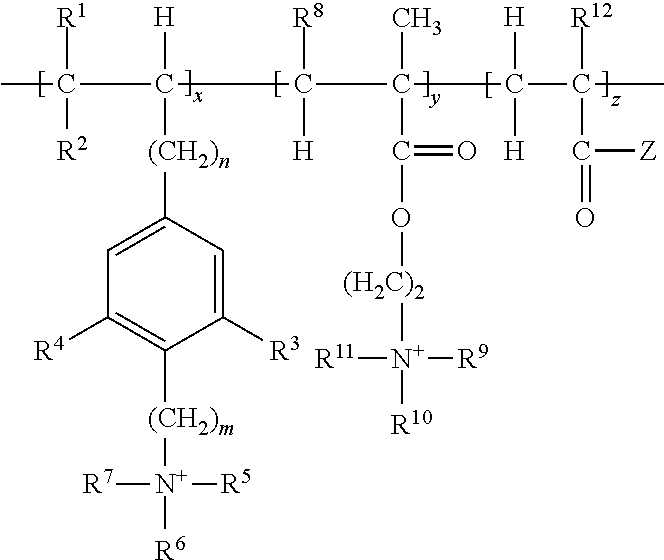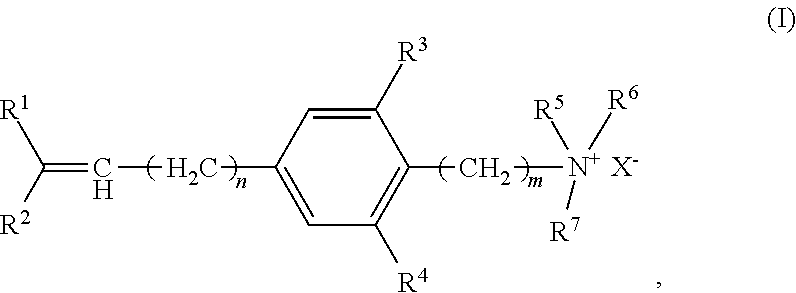Cationic copolymer and use thereof in lost circulation additive
a copolymer and additive technology, applied in the field of oil drilling, can solve the problems of serious leakage formation, low pressure formation, etc., and achieve the effects of reducing the viscosity and flow resistance of drilling fluid, increasing the loss of drilling fluid, and reducing the viscosity of the system
- Summary
- Abstract
- Description
- Claims
- Application Information
AI Technical Summary
Benefits of technology
Problems solved by technology
Method used
Image
Examples
example 1
[0046]This example illustrates steps of preparing cationic copolymer (A), wherein raw materials 1, 2, 3, and 4 were used to represent cationic monomer (a), non-cationic monomer (c), the initiator in the redox initiation system, and the oxidant and reductant in the redox initiation system, respectively.
[0047]Specifically, raw material 1 was 50 g of p-propenylbenzyldimethylethyl ammonium chloride. Raw material 2 was a total of 950 g of non-cationic monomers containing 850 g of acrylamide and 100 g of tert-butyl acrylate. Raw material 3 was an ethanol-water solution of azodiisobutyronitrile, which was prepared by dissolving 1.8 g of azodiisobutyronitrile in 400 g of an ethanol-water solution having an ethanol concentration of 50 wt %. Raw material 4 was an ethanol-water solution containing potassium persulfate and sodium sulfoxylate formaldehyde, which was prepared by dissolving 1.8 g of potassium persulfate and 3.2 g of sodium sulfoxylate formaldehyde in 100 g of an ethanol-water solu...
example 2
[0049]This example illustrates steps of preparing cationic copolymer (B), wherein raw materials 1, 2, 3, and 4 were used to represent cationic monomer (a) and cationic monomer (b), non-cationic monomer (c), the initiator in the redox initiation system, and the oxidant and reductant in the redox initiation system, respectively.
[0050]Specifically, raw material 1 comprised 150 g of cationic monomers including 100 g of p-vinyl-2,6-dimethylbenzyldimethylethyl ammonium chloride (i.e. cationic monomer (a)) and 50 g of methylbutyryloxyethyltrimethyl ammonium chloride (i.e. cationic monomer (b)). Raw material 2 comprised 550 g of acrylamide and 300 g of tert-butyl methacrylate, in total of 850 g of non-cationic monomers. Raw material 3 was an ethanol-water solution of azodiisobutyronitrile, which was prepared by dissolving 1.8 g of azodiisobutyronitrile in 400 g of ethanol-water solution having an ethanol concentration of 50 wt %. Raw material 4 was an ethanol-water solution containing potas...
example 3
[0052]This example illustrates steps of preparing cationic copolymer (C), wherein raw materials 1, 2, 3, and 4 were used to represent cationic monomer (a) and cationic monomer (b), non-cationic monomer (c), the initiator in the redox initiation system, and the oxidant and reductant in the redox initiation system, respectively.
[0053]Specifically, raw material 1 was comprised of 300 g of cationic monomers including 200 g of N,N,N-trimethyl-2-(2-amino-4-(2-methyl-1-propenyl)-6-hydroxybenzene)ethyl ammonium chloride (i.e. cationic monomer (a)) and 100 g of methylacryloxyethyltrimethyl ammonium chloride (i.e. cationic monomer (b)). Raw material 2 comprised 400 g acrylamide and 300 g of tert-butyl methacrylate, in total of 700 g of non-cationic monomers. Raw material 3 was an ethanol-water solution of azodiisobutyronitrile, which was prepared by dissolving 2.4 g of azodiisobutyronitrile in 400 g of ethanol-water solution having an ethanol concentration of 50 wt %. Raw material 4 was an et...
PUM
| Property | Measurement | Unit |
|---|---|---|
| mole fractions | aaaaa | aaaaa |
| mole fractions | aaaaa | aaaaa |
| zeta potential | aaaaa | aaaaa |
Abstract
Description
Claims
Application Information
 Login to View More
Login to View More - R&D
- Intellectual Property
- Life Sciences
- Materials
- Tech Scout
- Unparalleled Data Quality
- Higher Quality Content
- 60% Fewer Hallucinations
Browse by: Latest US Patents, China's latest patents, Technical Efficacy Thesaurus, Application Domain, Technology Topic, Popular Technical Reports.
© 2025 PatSnap. All rights reserved.Legal|Privacy policy|Modern Slavery Act Transparency Statement|Sitemap|About US| Contact US: help@patsnap.com



